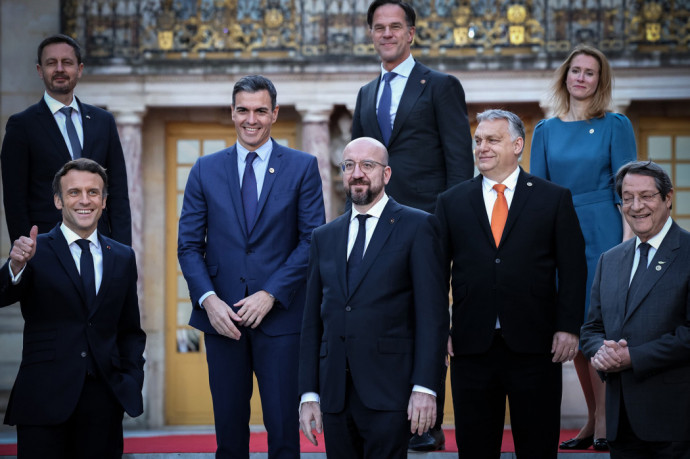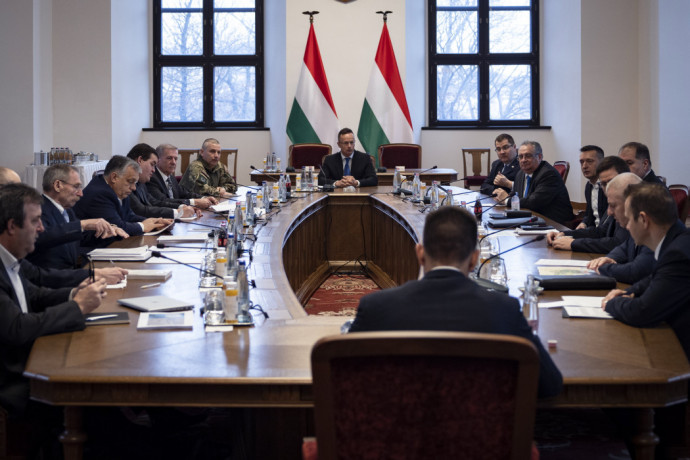Orbán is requesting the EU loan: after four big blows, Hungary has decided that cheap money is better than expensive money

The combination of Covid, the costs of the green transition, inflation (especially of energy prices), and the damage caused by the Russian invasion of Ukraine have already brought Hungarian economic policy to its knees. The disasters of biblical proportions have finally made the Hungarian political leadership realise that, even at the cost of some political loss of face, it needs the money from Brussels available in the form of a loan. Translation by Andrea Horváth Kávai
For days now, domestic economic and political experts have been buzzing about the fact that Hungarian Prime Minister, Viktor Orbán sent a letter to the presidents of the European Commission, the European Council and the European Parliament. The most important element of this letter is that Hungary is not only requesting the subsidies from the the EU’s RRF (Recovery and Resilience Facility) fund, but would also like to take advantage of the soft loan option (if possible, a really large amount). What’s more, he even asked for a loan, and the EU’s answer has already arrived: it is not likely that this request will be granted.
The main numbers
We could get into a lengthy analysis about what determines the amounts we are talking about (and we are not looking to get out of a more precise analysis, there will be one at the end of the article for those interested), but let’s start from the fact that in the case of Hungary, we are talking about 5800 billion forints.
The package has two elements:
- A grant: we have already requested this “free money”, approximately 2400 billion forints. Now we are first and foremost hoping to ensure that this amount will not be reduced due to various issues, as well as that it would finally start to trickle in.
- A loan: This is the refundable loan which we have so far refused, but would now love to receive in the amount of 3400 billion forints.
Do we understand this correctly? If Hungary’s GDP is around 50 thousand billion forints, then this would be more than a tenth, about 11,6 percent of the country’s GDP?
No, that is not correct. The reason being that this is a multiannual program, with the available amount divided up between the years, all the way until 2026.
It may be easier to understand the weight of the RRF for the Hungarian economy if we switch to euros. If the figures are compared, it will be clear that the amounts below are not exact, as we rounded up the numbers for clarity’s sake.
So, if the annual Hungarian GDP is 150 billion euros, then the RRF grant would provide us with approximately 1,5 billion euros, and the loan about 3 billion euros. So the grant would be around 1 percent of the GDP, and the soft loan about 2 percent of the same.
Where are we now?
Where are we now in the process? Hungary will most likely submit a formal loan application, listing eligible objectives, which will then be evaluated by the EU. Naturally, prior to the upcoming elections, communication that sends a message that “we are in control of the situation” will abound. Regardless of the level of self-confidence which will be oozing from the official communication in the weeks ahead, let us not forget that Hungary is in great need of these resources.
In the past two years alone, Hungary has faced funding difficulties in four huge and highly interlinked challenges.
- Covid and the now almost forgotten economic freeze.
- The goal of a green transition and net zero emissions, which will require tens of billions of forints by 2030 and 2050.
- The huge problems caused by high energy prices (our replacement rate is deteriorating, and the fight to keep overhead costs low is costing the government huge amounts of money).
- And most recently, the effects of Russia’s war on Ukraine (direct damage, financing humanitarian aid, investing in energy supply and investing in military development).
We will not be explaining the interdependencies of these areas at this time. Suffice it to say that the Russian invasion is affecting the energy prices, and that the green transition and the divestment from Russian gas overlap.
The cricket and the ant
We’ll get right back to the needed amount and our options, but let us briefly take a moment to look back at the recent past: how did we end up here?
There is no question about it: any one of the four listed difficulties would have devastated the economy on its own, neither of them is the result of a mistake made by Hungarians, we did not cause either of them to ourselves, but one thing can definitely be brought against the Hungarian economic policy: we have been acting like the cricket. In other words: why did we play our music and beat our drums so loudly while the weather was good and there was no wind? Even when external economic conditions were favourable, we were stimulating with low interest rates, we were giving money away, and we stimulated the economy with the so-called high-pressure economy programme.
But coffee is not to be drunk when one is already hyper, but in the morning, when one wakes up and is sleepy, and needs a kick to get going.
The irresponsibility of the so-called pro-cyclical economic policy backfired when the time of the ants came. Because we are going through a hard season now; those who did not save up, those who did not set aside intervention reserves do not have many tools left when the cold hits. Truth be told, in the good times we did manage to reduce the debt – to GDP ratio, but we knew no limits when it came to overheating.
The deceptive sunshine: there was money for all kinds of things
For an entire decade, between 2011 and 2021, Hungary had plenty of money for almost anything: both good and less useful packages were introduced. Without being judgemental or exhaustive, let’s just think about a few. For instance:
- the demographic packages
- the stadiums, the real estate purchases, purchasing pieces of art
- the so-called “Growth Loan Programme”
- the “Growth Bond Programme"
- all the company purchases within the energy sector, the infertility centres and banks
- the expensive sports events hosted by the country or
- stuffing the pockets of friendly investors at home or even beyond our borders.

Self-financing
In the midst of all the national programmes, the belligerent message of “self-reliance” was a recurring topic: we don’t need a loan from the IMF, we can afford to spend the Hungarian people’s money, we can afford to spend the Hungarian people's money more expensively, because sovereignty and self-financing are the real values.
Although there is some truth to this, it did seem like an exaggeration.
And then with Covid, this policy failed spectacularly. Instead of the unorthodox ideas and messages of György Matolcsy, the brave, visionary president of the Central Bank, the words of finance minister, Mihály Varga started becoming more important.
(The negotiations lead by László Balogh, Deputy State Secretary for Financial Policy, who also covers international finance also played an important role in the process.)
The Public Debt Management Centre’s leadership became much more standalone and professional, and about one and a half years ago, nicely and quietly, we began working on rational defence:
- we increased Hungary’s foreign exchange reserves
- we issued foreign currency bonds
- as the leaders from the inner circle put it: we did all we could to avoid Hungary being put on the IMF-respirator again.
Here comes the RRF
It might seem that up until this point, this article wasn’t really about the RRF, but of course, it was – using our sources, we have attempted to outline the context in which Orbán’s letter was written. In any case, it was in this challenging environment that the EU launched its major programme, the “Recovery and Resilience Facility” (RRF), through which it has offered vast amounts of money to member states.
In Hungary’s case, the maximized amount which includes a non-refundable grant, and a loan amounted to 5893 billion forints (or at least this was the number published at the time), and the achievable targets included green transition, digital transformation, innovation, social and territorial cohesion, healthcare, improving economic resilience, and education.
At this point, the goals are completely different, and they include military spending, supporting refugees, and disengagement from Russia, but we can still analyze it according to the old criteria.
We will take the lead
For a long time, the government and its leader, Viktor Orbán truly believed that after Covid we would be able to take the lead in Europe.
Our politicians wanted to take advantage of the large amounts of EU funds that were opening up at record speed. In conversations in the background they spoke about their big goals with starry eyes. It is also true that according to some, the rush was also to make sure that in case Fidesz doesn’t win the elections in 2022, there would be a lot of money secured “in good hands”.
The only trouble was that the question of the RRF brought a big problem to the surface, and Fidesz’ leadership had miscalculated – but its voters will never notice it in this form and will never hold that against them.
The confident Fidesz leadership thought that the constant criticism of “Brussels”, the serious corruption cases, the embarrassing anti-gay measures, and yes, even the constant friendly behaviour with China, Russia, Turkey and Azerbaijan can be continued without consequences. They thought that nobody would say anything, as the unity of the Union is more important.

And they did not, until Hungary decided that the grant part of the RRF will suffice, and it doesn’t intend to take a loan. All of a sudden, the leadership had to realize that this money would not be paid out that easily. In such cases, the EU does a bit of “investigation”, they might even voice some criticism (mostly about corruption, as that affects the appropriation of the funds), but there isn’t too much official criticism to be heard – it’s just that the money is not arriving, and the assessment is not moving forward.
In the meantime, it was clear that Hungary would be able to access the international bond market due to the abundance of liquidity, but all of our own actions, foreign currency bonds, green bonds, yuan bonds, and yen bonds were in vain. It was becoming obvious that coming up with the 20-40 thousand billions at a good price from the market would not be so easy.
The realization
At this point, we were beginning to realise that although still confident, Hungary is aware that it would be very good to access all the EU funds. This includes the above mentioned RRF, as well as the TSI (Technical Support Instrument) which is part of the RRF. The TSI supports the Member States which are taking in Ukrainian refugees, and it also provides assistance in phasing out dependency on fossil fuels from Russia.
In the end, Viktor Orbán made the right decision. At least, it will for sure be considered that in the adventure novel entitled “Viktor Orbán and the financing of Hungarian debt”. Although he does not come across as the “begging-pushover” type, when the one month domestic deficit reached 1585 billion forints in February, although he did not stop handing out money (we all received the tax rebate, which – at the time of severe deficit – can only be interpreted as looking to gain votes at the upcoming elections), he accepted the fact that he will have to return to Brussels and will have to beg.
On top of it all, it will not be enough to simply ask, they would have to work for it: they knew they would have to put together good materials and reasonings, as well as lower the volume on claims saying that EU membership is after all a contract, and this is owed to us. The fact that this is owed to us doesn’t help much if requested funds never make it to the country.
It’s not here yet, but it isn’t that much anyways
And now let’s look at the less joyful messages! Although the RRF is important, it is not that much money, and it isn’t here yet. Of course, 5800 billion forints is a huge amount of money, but it would be dispensed in instalments, targeting special goals – and today, it is still just an option. For the time being, it cannot be calculated with, and the ÁKK cannot include it in Hungary’s financing plan.
And how is it to be looked at, once it finally arrives? The grant-type elements can be considered as gifts, which are great if they help with Hungary’s debt situation. If, for example, a military development should have been carried out with budgetary resources, but we receive the resources for it, then the budget balance does not deteriorate so much, and we do not have to find credit for this task.
The loan part of the RRF is a foreign currency loan. Hungary has recently moved towards foreign currency financing, with the ÁKK now saying that up to 25 percent of the debt can be financed in foreign currency (this used to be 20 percent), and we could fit within this limit with the RRF loan as well (we repeat: the money would not all be coming at the same time).
What we don’t yet know is the most important thing: How much does this loan cost?
What is its price, and what is it all for?
Naturally, whether it’s worth it or not will have to be examined, but the answer will either way be that it’s worth it, because it’s cheaper.
The loan doesn’t have a predetermined fixed interest rate, but the EU will issue bonds, which will be transferred to the member states, but the entire EU’s interest rate will for sure be lower than Hungary’s. Getting a loan on EU terms is more advantageous than getting one on Hungarian terms.
This is why it is joyful news that we stopped being stubborn, and accepted the fact that the cheaper loan is better,
and if foreign currency sources come in, that increases the country’s foreign exchange reserve, helps balance payments, diversifies financing, and strengthens the forint. We need all of these right now, because otherwise, we are looking at some very difficult times ahead.

For the Hungarian economy, there are many factors that could present as issues and risks in the future.
The fight against inflation is going to be very difficult. Think about it: in the West, in a normal market economy, inflation is self-reducing. Of course it is a heavy blow if a family has to pay three times as much as before for overhead costs, but if a family can afford fewer consumer goods as before, demand and prices will both fall. There is a natural decrease in inflation. Hungary is not saving more energy with our overhead prices. This is not only bad for environmental reasons, and it is not just slowing down our detachment from Russian gas, but if our demand is not reduced, neither will inflation be.
As we go from the cold towards the warmer weather, the pressure caused by energy prices might start to ease, but now the whole world is fearing food-based inflation. On the one hand, the produce of two major producers, Russia and Ukraine will be partly lost, but on the other hand, high gas prices will make fertilisers more expensive or in short supply.
Let us consider some other aspects of the Hungarian economy: will tourism begin to pick up with a war happening next door? Is this where an American or German tourist would want to come now? Are European car manufacturers, which are present in Hungary worried about the loss of Russian customers? After all, although it is not one of the most solvent markets, it is one of the most populous ones.
And finally, a word on interest rate hikes. Naturally, protecting the forint (keeping it within 365-380 to the euro) is in our best interest, but higher interest rates are cooling, fewer people are investing in real economy, more are looking to save, and unfortunately, investments may be set back due to “the east wind”.
So there will be ample space for the protection provided by the RRF.
A little bypass
And finally, as promised earlier in this article, an economic digression.
Although neither the loan nor the grant are here yet, Hungary is already launching tenders for the hoped-for RRF.
Pertaining to the RRF, Member States have until 31 August 2023 to apply for credit support of up to 6.8% of their 2019 GNI, and the funds need to be appropriated until 2026.
The Gross National Income (GNI) is an indicator derived from the GDP. It takes into account primary income received from abroad and paid to abroad. In other words, it does not include the income generated by foreign ownership of capital operating in Hungary and the income of foreign workers in Hungary, but it does include the income earned abroad by Hungarian investors and workers, and the balance of subsidies and taxes paid from the European Union.
The difference between the two is not significant in Hungary, we can say that in terms of the GDP and the GNI we are talking about 50 thousand billion forints a year, which in Hungary is matched by 80%, or about 40 thousand billion forints of debt.
If you would like to receive more similar analyses about Hungary directly in your inbox, sign up for the Telex English newsletter here!